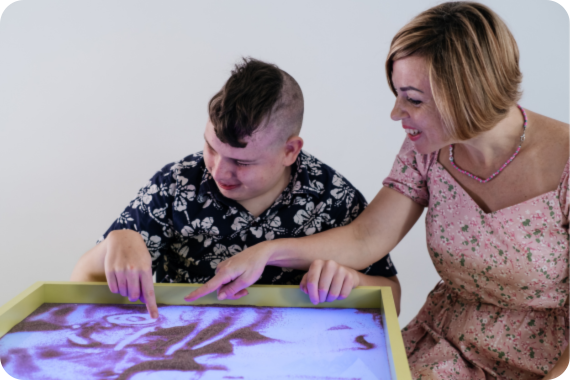
Participatory design for and with people with cognitive impairments: tailoring collaboration for empowerment
2025-11-09
Designing with individuals who have cognitive impairments—such as autism, ADHD, traumatic brain injuries (TBI), or intellectual disabilities—is not just about creating tools; it’s about fostering connection, understanding, and empowerment. No two cognitive profiles are the same, and a rigid, one-size-fits-all approach often falls short. Participatory design, when thoughtfully tailored to the unique needs and capabilities of users, becomes a powerful way to create solutions that truly resonate. This blog dives into how to customize participatory design sessions and shares practical strategies for making collaboration meaningful, effective, and even fun.
Why tailoring participatory design sessions matters
Imagine trying to solve a puzzle with pieces that don’t fit. That’s what it feels like for someone with cognitive impairments when tools or processes aren’t designed with their needs in mind. For example, a person with ADHD might thrive in fast-paced, interactive sessions but struggle with long, detailed instructions. Someone with autism might prefer structured routines and visual aids over open-ended brainstorming. And for individuals with TBI, fatigue can make lengthy sessions overwhelming, requiring shorter, more frequent breaks.
Tailoring participatory design sessions isn’t just about making things easier—it’s about making them possible. By adapting the process to fit users’ strengths and limits, we create an environment where they feel valued and heard. This not only leads to better solutions but also empowers participants, giving them a sense of agency and ownership over the outcomes.
Key strategies for customizing participatory design
1. Start with understanding: pre-session assessment
Before jumping into design work, take the time to understand the people you’re designing with. This might mean consulting caregivers to learn about triggers, communication preferences, and energy patterns. For nonverbal participants, this could involve introducing picture-based activities or assistive devices. Observational visits to users’ environments—like their homes or classrooms—can also reveal how they interact with existing tools.
For instance, noticing that a user responds well to tactile feedback might lead to incorporating 3D models or textured materials into the session. The goal is to gather insights that help shape a session where everyone can participate meaningfully.
2. Structure sessions for comfort and engagement
Once you’ve gathered insights, structure the session to align with participants’ capabilities. Break activities into shorter, manageable chunks—think 15–20 minutes with frequent breaks to prevent fatigue. Use visual schedules or timers to help users anticipate transitions, and create a calm, clutter-free environment to minimize sensory overload.
For example, a quiet space with neutral lighting can make a world of difference for someone with sensory sensitivities. These small adjustments create a safe, welcoming space where participants can focus on the task at hand.
3. Use tools that speak their language
Not everyone communicates or learns in the same way. Visual aids like sketching or drag-and-drop interfaces can reduce reliance on verbal explanations, making sessions more accessible for those with language barriers. Tactile prototypes, such as textured materials or physical models, can engage users who learn through touch.
Gamification is another powerful tool. Turning feedback into a game—like voting for design options with colored stickers—can make the process fun and low-pressure. Plus, it’s not just engaging for participants with cognitive impairments; it also makes collaboration more enjoyable for everyone involved. Who doesn’t love a bit of fun with stickers? The key is to choose methods that align with participants’ strengths and preferences while keeping the atmosphere light and enjoyable.
4. Adapt in real time
Participatory design is a dynamic process, and flexibility is key. Mid-session check-ins—using simple gestures like thumbs-up or thumbs-down—can help gauge comfort levels. If a participant disengages, don’t be afraid to pivot. Simplify the task, switch activities, or revert to low-tech tools like paper sketches.
After the session, debrief with caregivers and users to refine your approach. For example, if a digital prototype frustrates users, paper-based iterations might bridge the gap until the design stabilizes. This iterative approach ensures that the process remains responsive to users’ needs.
Overcoming common challenges
Group sessions can highlight conflicting needs. A participant with ADHD might crave fast-paced tasks, while someone with autism prefers predictability. To address this, assign focused roles—one user might critique aesthetics, while another tests usability. Modular designs also help balance personalization with scalability. For instance, a task-management app could let users toggle between text, audio, or icon-based modes depending on their daily energy levels.
Fluctuating abilities pose another challenge. A user with TBI might have high focus one day and fatigue the next. Building flexibility into the design process—such as adjustable difficulty levels or optional features—ensures solutions remain usable across varying conditions.
Practical tips for effective collaboration
- Start small: Begin with one-on-one sessions to build rapport. Gradually expand to group settings as participants grow comfortable.
- Co-create ground rules: Let users set norms like “we take turns” or “no wrong answers” to foster ownership and reduce anxiety.
- Leverage familiar concepts: Frame abstract tasks through relatable analogies. For example, compare designing an app to “following a recipe,” where each step builds on the last.
- Celebrate contributions: Acknowledge all input, whether a sketch, a suggestion, or even nonverbal cues like smiles. Phrases like, “your idea is really insightful!” reinforce value.
The role of technology in tailored participatory design
Technology can be a powerful ally when used thoughtfully. AI-driven apps might adjust interface complexity based on real-time user performance, while AR simulations could let users test designs in risk-free virtual environments. However, technology should complement human intuition, not replace it. A therapist’s ability to interpret nonverbal cues or a caregiver’s insight into historical preferences remains irreplaceable. For example, a voice assistant co-designed with dyslexic students and educators balances tech efficiency with human empathy.
Conclusion: empowerment through adaptation
Tailoring participatory design sessions for cognitive impairments isn’t just about accessibility—it’s about dignity. By adapting methods to fit users’ rhythms, strengths, and needs, we create solutions that truly resonate. Whether designing a communication tool for autism or a memory aid for TBI, the key lies in listening deeply, iterating patiently, and valuing every voice in the room. Inclusivity isn’t a checkbox; it’s a dynamic process of learning, adjusting, and growing together. And who knows? Along the way, you might just have a little fun with stickers, too.
Keep exploring
Check out these related posts for more insights and inspiration.
Want more insights like this?
Subscribe for exclusive blog previews, open-source toolkits, and invites to community co-design.


